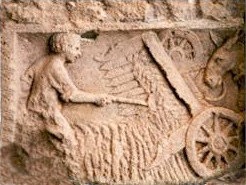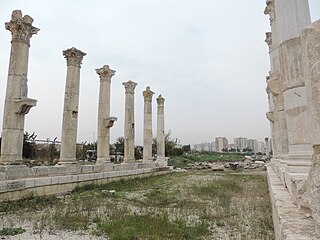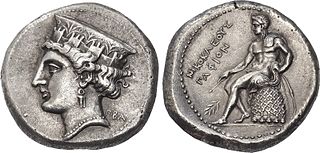Related Research Articles

AD 14 (XIV) was a common year starting on Monday of the Julian calendar. At the time, it was known as the Year of the Consulship of Pompeius and Appuleius. The denomination AD 14 for this year has been used since the early medieval period, when the Anno Domini calendar era became the prevalent method in Europe for naming years.
The 0s BC is the period between 9 BC and 1 BC, the last nine years of the before Christ era. It is one of two "0-to-9" decade-like timespans that contain nine years, along with the 0s.
This article concerns the period 29 BC – 20 BC.

Marcus Terentius Varro was a Roman polymath and a prolific author. He is regarded as ancient Rome's greatest scholar, and was described by Petrarch as "the third great light of Rome". He is sometimes called Varro Reatinus to distinguish him from his younger contemporary Varro Atacinus.
In Greek mythology, Tlepolemus was the leader of the Rhodian forces in the Trojan War.

Lucius Junius Moderatus Columella was a prominent Roman writer on agriculture in the Roman Empire.

Roman agriculture describes the farming practices of ancient Rome, during a period of over 1000 years. From humble beginnings, the Roman Republic and the Roman Empire expanded to rule much of Europe, northern Africa, and the Middle East and thus comprised many agricultural environments of which the Mediterranean climate of dry, hot summers and cool, rainy winter was the most common. Within the Mediterranean area, a triad of crops were most important: grains, olives, and grapes.
Centuria is a Latin term denoting military units originally consisting of 100 men. The size of the centuria changed over time, and from the first century BC through most of the imperial era the standard size of a centuria was 100 men. By the time of the Roman Empire, ordo became a synonym of centuria.

Carsoli is a town and comune in the province of L'Aquila, Abruzzo. The ancient Roman city lies 4 kilometres (2.5 mi) southwest of the modern town.

Soli, often rendered Soli/Pompeiopolis, was an ancient city and port in Cilicia, 11 km west of Mersin in present-day Turkey.
Alban wine is a notable wine of Ancient Rome that was grown in the Colli Albani region, 20 kilometres (12 mi) Southeast of Rome, at the foot of Mt. Albus. The area is now occupied by the modern day papal residence of Castelgandolfo. The land was praised by Columella: "For there is no doubt that, of all the vines that the earth sustains, those of the Massic, Surrentine, Alban, and Caecuban lands hold first place in the excellence of their wine".
The jugerum or juger was a Roman unit of area, equivalent to a rectangle 240 Roman feet in length and 120 feet in width, i.e. 28,800 square Roman feet or about 1⁄4 hectare (0.623 acre).

Moretum is an herb cheese spread that the Ancient Romans ate with bread. A typical moretum was made of herbs, fresh cheese, salt, oil, and vinegar. Optionally, different kinds of nuts could be added. The ingredients were crushed together in a mortar, for which the dish is named.

.
Sareisa or Shareisha was an ancient city in southeast Anatolia, near Tigris. It is mentioned by Strabo as a city of Cordyene. Ancient Assyrian inscriptions mention it as 'Shareisha' or 'Shereshe'; Tiglath-Pileser I reports his conquest of the city and defeat of the forces of Kurte.
In Greek mythology, Demonassa or Demonassae was a name attributed to five women.

Quintus Caecilius Metellus was a pontiff in 216 BC, aedile of the plebeians in 209 BC, curule aedile in 208 BC, magister equitum in 207 BC, consul in 206 BC, dictator in 205 BC, proconsul of Bruttium in 204 BC, and an ambassador at the court of Philip V of Macedon in 185 BC.
The Senses, or Sense, were a Dacian tribe in the southern region of Dacia.
The Battle of the Isère River took place near the modern day French town of Valence at the confluence of the Isère and Rhône rivers. A first confrontation had been won by Gnaeus Domitius Ahenobarbus at the Battle of Vindalium, further south in the Rhône Valley, before Ahenobarbus and Quintus Fabius Maximus Allobrogicus joined their forces, defeating a confederation of Allobroges, Arverni and some Salluvii warriors at the Isère River.
The Battle of Myus was a military engagement that took place in 311 BC. The battle occurred in Syria or more generally, the Levant, at an unknown location named Myus, between an Antigonid force led by Demetrius I Poliorcetes and a Ptolemaic force under the command of a close associate of Ptolemy, Cilles. It concluded with an Antigonid victory, permitting to mitigate the defeat of Gaza, and likely led to the Peace of 311 BC among the various Diadochi.
References
- ↑ Christopher Francese (2007). Ancient Rome in So Many Words. Hippocrene Books. pp. 170–. ISBN 978-0-7818-1153-8.
- ↑ Annalisa Marzano (2007). Roman Villas in Central Italy: A Social and Economic History. BRILL. pp. 149–. ISBN 978-90-04-16037-8.
- ↑ "C. Suetonius Tranquillus, Divus Augustus, chapter 32". www.perseus.tufts.edu. Archived from the original on 2023-08-16. Retrieved 2023-08-16.
- ↑ William Smith (1875). "Ergastulum". A Dictionary of Greek and Roman Antiquities. London: John Murray.
- ↑ "Columella, Lucius Junius Moderatus, Res Rustica, Books I-IV, book 1, chapter pr". www.perseus.tufts.edu. Archived from the original on 2022-05-21. Retrieved 2018-02-05.
- ↑ "Columella, Lucius Junius Moderatus, Res Rustica, Books I-IV, book 1, chapter 6, section 3". www.perseus.tufts.edu. Archived from the original on 2022-05-21. Retrieved 2018-02-05.
- ↑ Columella (1941). On Agriculture: Volume 1, Books 1-4. Translated by Harrison Boyd Ash. Cambridge, MA: Harvard University Press.
- ↑ "LacusCurtius • Columella, De Re Rustica — Book I". penelope.uchicago.edu. Archived from the original on 2023-12-29. Retrieved 2018-02-05.
- ↑ "Columella, Lucius Junius Moderatus, Res Rustica, Books I-IV, book 1, chapter 8". www.perseus.tufts.edu. Archived from the original on 2022-05-21. Retrieved 2018-02-05.
- ↑ "LacusCurtius • Columella, De Re Rustica — Book I". penelope.uchicago.edu. Archived from the original on 2023-12-29. Retrieved 2018-02-05.
- ↑ "LacusCurtius • Columella, De Re Rustica — Book I". penelope.uchicago.edu. Archived from the original on 2023-12-29. Retrieved 2018-02-05.
- ↑ "Columella, Lucius Junius Moderatus, Res Rustica, Books I-IV, book 1, chapter 3". www.perseus.tufts.edu. Archived from the original on 2022-05-21. Retrieved 2018-02-05.